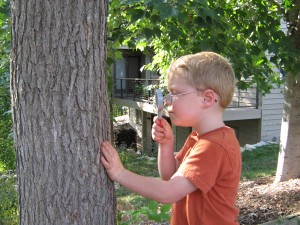Hemlock Holmes: Tree Detective

Originally appears in the Spring 2013 issue
If trees could talk, what would they tell us? If, like Disney’s Pocahontas or the growing child of Shell Silverstein’s “The Giving Tree,” we were to take a seat beside a majestic oak and ask it to tell us its story, what would it say? Perhaps it would speak of raging forest fires of centuries past, or of prolonged droughts that threatened entire regions. While we know only fantastical trees converse with voices, the pattern of a tree’s rings allows scientists to access a record of its natural history. Deciphering this code is a way that students can communicate with trees.
Dendrochronology is the study and analysis of tree ring patterns. Each year in the spring and summertime, a tree produces a new ring of cells in the cambrium layer beneath its bark, making the tree a natural keeper of time. What is more, the width of each ring corresponds to the climatic and environmental conditions the tree experienced during its growth. Years with favorable growing conditions will produce wider rings, whereas growing seasons offering fewer resources will be signified by thinner bands of cells. Thus, by observing the width of a tree’s rings, we are able to piece together the past.
In the following unit “Hemlock Holmes: Tree Detective,” students use the study of trees to explore the connection between the work of detectives and that of environmental scientists. Like the sleuths ubiquitous in children’s literature, scientists must gather evidence and make inferences in order to find the answers to their most burning questions. The following four activities will lead your class of junior detectives through a series of outdoor and hands on learning activities with connections to science, literacy, and mathematics.
To view the photo-rich magazine version, click here.
If you are not already a subscriber, please subscribe to read the full article
Emily Hogan is a geography student and an environmental education researcher at Mount Allison University in Sackville, New Brunswick. The “Hemlock Holmes” unit was based off of the research of dendrochronologist Dr. Colin Laroque and was piloted by Matt Ripley’s Grade 2 class at Salem Elementary School.
Leave a Reply
You must be logged in to post a comment.










